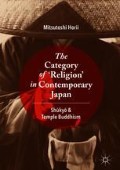Abstract
In January 2011, I was on a long-haul flight from Tokyo to London. In the middle of a rather uncomfortable 12-hour journey in economy class, I was scanning through the airline magazine, just for the sake of killing a few minutes out of those 12 hours. I did not expect to find something which I would actually like to read, but surprisingly the article entitled “Temple Attraction” caught my attention. It started with the sentence: “The days when a temple visit was a strictly solemn affair appear to be over, as Japan’s ubiquitous places of Buddhist worship open their gates to market traders and even yoga enthusiasts” (Skyward, January 2011, p. 4).
Access this chapter
Tax calculation will be finalised at checkout
Purchases are for personal use only
Notes
- 1.
Here I employ the term ‘denomination,’ rather than ‘sect,’ in order to refer to schools of Temple Buddhism. This is because their predominant characteristics do not seem to resonate those of ‘sects,’ but rather those of ‘denominations.’ In the sociological discourse, for example, a ‘sect’ is a typology of organisations which are characterised by strong integration and commitment amongst members and the presence of a charismatic leader (Troeltsch 2007 [1912]). This typology seems to be more applicable to so-called ‘New Religions ’ rather than schools of Temple Buddhism. In this light, for example, Wilson (1970) employs the term ‘sect’ in order to refer to Japanese New Religions. In contrast, Temple Buddhism in general does not show ‘sectarian’ characteristics. The commitment of its followers tends to be very loose. Any presence of charismatic leaders is very difficult to discern. Temple Buddhism generally accepts the norms and values of society, and different schools often cooperate with each other in affairs of common interest. This is in fact very similar to what, for example, Niebuhr (1929) called ‘denomination.’ Various sociologists employ this term to refer to Christian Churches, which are not mainstream but socially established, such as Methodists and Baptists. However, some scholars of Japanese Buddhism , such as Jaffe (1997, 1998, and 2001) have already adapted the term to the study of Temple Buddhism. I employ the term in the same manner.
Bibliography
Borup, Jorn. 2008. Japanese Rinzai Zen Buddhism: Myōshinji, a living religion. Leiden: Brill.
Bunkachō. 2017. Heisei 28 nendo Shūkyōnenkan. Tokyo: Gyōsei.
Covell, Stephen. 2005. Japanese Temple Buddhism: Worldliness in a Religion of Renunciation. Honolulu: University of Hawai’i Press.
Covell, Stephen. 2008. The Price of Naming the Dead: Posthumous Precept Names and Critiques of Contemporary Japanese Buddhism. In Jacqueline Stone and Mariko Namba Walter eds. Death and the Afterlife in Japanese Buddhism, Honolulu: University of Hawai’i Press, pp. 293–324.
Douglas, M. 2002 [1966]. Purity and Danger: An Analysis of Concepts of Pollution and Taboo. London: Routledge.
Durkheim, Emile. 1995 [1912]. The Elementary Forms of Religious Life. London. Free Press
Fitzgerald, Timothy. 1997. A Critique of “Religion” as a Cross-Cultural Category. Method & Theory in the Study of Religion 9(2): pp. 91–110.
Fitzgerald, Timothy. 2000. The Ideology of Religious Studies. Oxford: Oxford University Press.
Fitzgerald, Timothy. 2003. ‘Religion’ and ‘the Secular’ in Japan: Problems in History, Social Anthropology, and the Study of Religion. Electronic Journal of Contemporary Japanese Studies, Discussion Paper 3 in 2003. Available at: http://japanesestudies.org.uk/discussionpapers/Fitzgerald.html. Last Accessed: 25 Nov. 2011.
Heine, Steven. 2012. Sacred High City, Sacred Law City. London: Oxford University Press.
Howland, Douglas. 2001. Translating Liberty in Nineteenth-Century Japan. Journal of the History of Ideas 62 (1): pp. 161–181.
Isomae, Jun’ichi. 2003. Kindai nihon no shūkyō-gensetsu to sono keifu. Tokyo: Iwanami-shoten.
Isomae, Jun’ichi. 2014. Religious Discourse in Modern Japan: Religion, State, and Shintō. Leiden: Brill.
Jaffe, Richard. 1997. The Buddhist Clerics and Japanese Subject: Buddhism and the Household Registration System. In Helen Hardacre and Adam Kern eds. New Directions in the Study of Meiji Japan. New York: Brill, pp. 506–530.
Jaffe, Richard. 1998. Meiji Religious Policy Sōtō Zen, and Clerical Marriage Problem, Japanese Journal of Religious Studies 25: pp. 45–85
Josephson, Jason Ānanda. 2012. The Invention of Religion in Japan. London: The University of Chicago Press.
McFarland, H. N. 1967. Rush Hour of the Gods: A Study of New Religious Movements in Japan, New York: Macmillan.
Skyward, January 2011, p. 4. Temple Attraction.
Troeltsch, Ernst. 2007 [1912]. The Social Teachings of the Christian Churches vols. 1 and 2. Louisville, KY: Westminster John Knox Press.
Wilson, Bryan. 1970. Religious Sects: A Sociological Study. London: World University Library.
Author information
Authors and Affiliations
Rights and permissions
Copyright information
© 2018 The Author(s)
About this chapter
Cite this chapter
Horii, M. (2018). Introduction. In: The Category of ‘Religion’ in Contemporary Japan. Palgrave Macmillan, Cham. https://doi.org/10.1007/978-3-319-73570-2_1
Download citation
DOI: https://doi.org/10.1007/978-3-319-73570-2_1
Published:
Publisher Name: Palgrave Macmillan, Cham
Print ISBN: 978-3-319-73569-6
Online ISBN: 978-3-319-73570-2
eBook Packages: Social SciencesSocial Sciences (R0)

